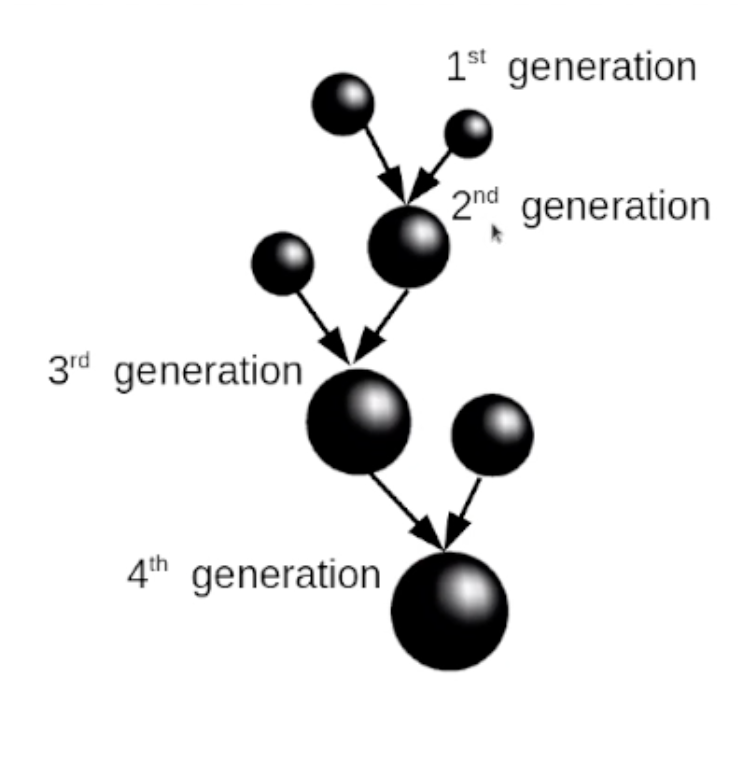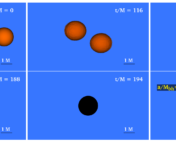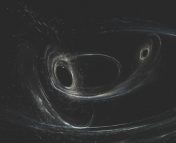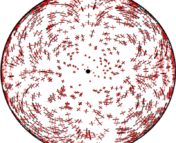Welcome to the Astrobites coverage of the 2022 April APS Meeting! Some of our authors this week will be in-person while others are attending virtually! We will report on highlights from each day here, from APS Press Conferences to graduate student research talks. If you’d like to see more timely updates during the day, we encourage you to search the #aprilAPS hashtag on twitter. We’ll be posting once a day during the week, so be sure the visit the site often to catch all the news!
Astrophysical Implications of GW190521 (by Briley Lewis)
In 2020, LIGO/Virgo announced the detection of gravitational waves from the most massive black hole binary we’ve seen so far, known as GW190521. The two black holes in this binary were a whopping 85 and 66 solar masses, and created an even bigger black hole, weighing in at 142 solar masses. What makes this detection so unique, though, isn’t that they were just massive—it’s that these black holes were unexpected in their size.
Previously, astronomers had thought there should be a “mass gap”—a range of masses, from about 50-120 solar masses, where we didn’t find any black holes of those sizes. GW190521 knocked that idea on its side, becoming the first detection of a so-called Intermediate Mass Black Hole (IMBH). Now, astronomers are working to figure out how these black holes in the mass gap came to be, which was the focus of this session on Day 3 of the APS April Meeting.
Michela Mapelli (University of Padova) discussed the possibility that IMBH could originate in Young Star Clusters (YSCs). The relaxation times for YSCs are quite short compared to other clusters, which means that things can sink to the center more quickly and interact before black holes even have time to form. The mass gap is thought to be from pair-instability supernovae, where the star is so massive it explodes too aggressively to leave a remnant behind, so we need another way for IMBH to form here. Collisions between two big stars in the dense environment of YSC’s center can then create a weird star with a small core, which can collapse to a black hole while avoiding the pair-instability problem to create an IMBH.
This isn’t the only way to form an IMBH, though—they could also form through hierarchical mergers, where smaller black holes merge repeatedly to make something big. Abbas Askar (Lund Observatory) went into more detail on this, describing how gravitational encounters in dense stellar environments—like the cores of YSCs or other clusters—can create the binary black hole mergers we observe with gravitational waves.

The one problem is that black holes might get kicked out of the cluster entirely when they’re born or after they merge, making hierarchical mergers impossible. A black hole forming through a core-collapse supernova or direct collapse gets a “natal kick” when it’s created, and simulations show that the fraction of black holes that stay in clusters can be as high as 60% or as low as 1% depending on exactly how you compute these kicks. The kicks from mergers can be smaller if the merging black holes have low spins, or maybe merging black holes only stay put in the densest star clusters. One big takeaway: “GW190521 and similar detections are consistent with dynamical formation!”
Rob Farmer (Max Planck Institute for Astrophysics) also reminded everyone that we don’t necessarily know where/when these binary black holes formed, so we have to worry about the fact that LIGO/Virgo might be observing multiple populations of black holes at the same time. The mass gap can be different depending on a whole bunch of factors, including the environment the black holes formed in, the physics in your models, and more! Interestingly, though, the detections of black hole mergers can actually put constraints on different stellar reactions, like the C12(a,g)O16 rate. So, if these black holes like GW190521 are formed from stars, then they can help us learn about stellar evolution!
The recording of this session (S03) will be available to registered April APS attendees until July 12, 2022 at the link here and our live-tweeting here.

Gravitational Wave Detection with LISA (by Sumeet Kulkarni)
With the ground-based gravitational wave detectors having made one of the breakthroughs of the century through the detection of gravitational waves from stellar-mass mergers of compact objects, the focus is now on LISA, the space-based gravitational wave observatory to unlock another avenue in this new way of probing the cosmos. This APS April session was dedicated to exploring the wonderful array of astrophysical sources LISA may see, and the instrumental challenges of their detection using laser interferometry in space.
The first talk of the session was given by Jessica Page from the University of Alabama in Huntsville, who spoke about the technique of bayesian time-delay interferometry and its role in suppressing laser frequency noise, a dominant source of noise for LISA.
This was followed by Matthew Digman (Montana State University) who highlighted the fact that LISA will face time-varying noise from an astrophysical source as well! This noise comes from the combined cacophony produced by the abundance of white dwarf binaries present at the center of the Milky Way. LISA’s changing configurations as it co-revolves with the Earth around the Sun will mean that this background noise will vary in strength. Characterizing this variation will help us pick out actual sources from the background at different times.
Roberto Cotesta from Johns Hopkins University was next, competing for one of the longest APS April talk titles: “Where are you? How fast do you spin? Bayesian parameter estimation on a population of massive black-hole binaries using an inspiral-merger-ringdown waveform model with higher harmonics”. His team’s very interesting work focussed on the population of ‘golden binaries’ that LISA will detect, consisting of very loud gravitational wave signals from supermassive black holes with masses between a tenth of a million to a billion times the mass of the Sun. LISA will be able to measure the mass and spins of these supermassive black holes with very small uncertainties of less than a percent. In addition, it will be able to pinpoint the sky location of these events to a small region of 0.1 square degrees, equivalent to half the size of the Moon.
The next talk was given by Vladimir Strokov, also from Johns Hopkins, on the search for the elusive intermediate-mass black hole (IMBH) binaries with LISA, particularly from Milky Way globular clusters. Their technique focuses on a triple-system scenario where a stellar-mass binary black hole orbits an IMBH at the center of a globular cluster. In this case, the gravitational wave signal coming from the BBH will be doppler shifted as it radially approaches towards and recedes away from us in orbit, enabling us to measure its rate of revolution and in turn, the mass of the central IMBH. Examining known globular clusters, they find that an IMBH at the center of Omega Centauri would be a promising candidate to detect using LISA.
Daniel J Oliver (University of Arkansas) presented the next talk which looked at Extreme Mass Ratio Inspiral (EMRI) systems, where a stellar mass black hole moves in highly elliptical orbits around a supermassive black hole. EMRIs by themselves are a promising source of gravitational waves for LISA. However, an ensemble of EMRIs in their early eccentric orbits may cause unresolvable background noise in LISA data, obscuring its ability to detect other gravitational-wave sources. Oliver’s group simulates EMRI sources and models their orbits to better characterize their background noise spectrum.
LISA’s (superstar) supermassive black hole sources are commonly surrounded by an accretion disk. Andrea Antonelli from Johns Hopkins University presented a talk on measuring the effects of these accretion disks on the gravitational wave signals from SMBH mergers. Various hydrodynamical effects such as accretion winds and dynamical friction can generate torques that affect the trajectory of the black holes as they merge. This can leave detectable imprints on the gravitational wave signals, and can even help us distinguish between different models of accretion disks.
Finally, Brian Seymour from Caltech presented prospects of viewing sources from GW observatories sensitive in different bands of the spectrum, starting from low-frequency waves in the millihertz range with LISA, mid-frequency waves in the decihertz range with the proposed deci-hertz gravitational-wave observatory (decigo), and higher frequency waves in the kilohertz range with LIGO-Virgo. A particularly exciting prospect is to use black hole mergers as dark sirens in cosmological studies. With observations in multiple GW bands across detectors, dark sirens can be better localized using joint signals across detectors and help us identify individual galaxies where they come from.
All things considered, detecting new kinds of gravitational-wave sources with LISA will be a fantastic next milestone in the field of gravitational wave astrophysics in the coming decades, one that everyone in the room was eagerly looking forward to!
Featured Image Credit: APS April 2022
Edited By: Sumeet Kulkarni, Briley Lewis, Huei Sears




